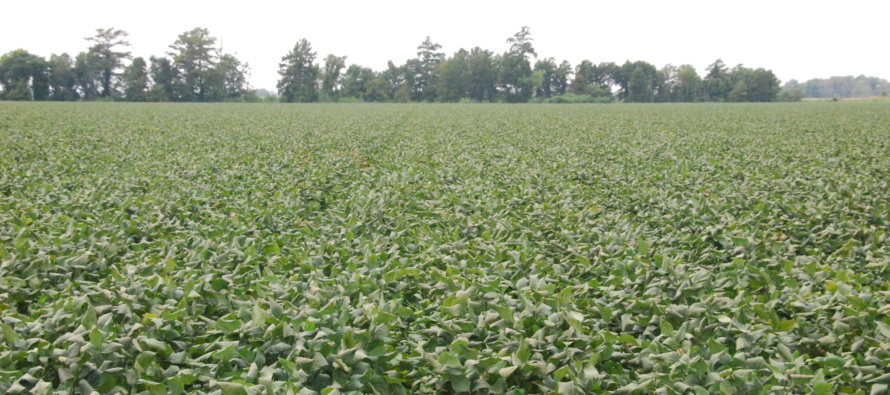Soybean Disease Update: July 16, 2016

Related Articles
- 2010 Soybean And Corn Variety Trial Data 3
- Rice Variety Trial Results For 2010, Plus Rice Research Report 0
- Evaluation of Peanut Prescription Rx Program in Mississippi 0
Latest Tweets
The soybean disease situation remains quiet for the most part. A few leaf spot diseases are picking up throughout the state. In addition, as soybean reaches more advanced reproductive growth stages, the stem diseases observed tend to increase. Be mindful that numerous stem and root diseases can result in the observation of interveinal necrosis developing in the upper canopy.

When diagnosing frogeye leaf spot look for the production of fungal reproductive structures on the underside of the leaf.
Frogeye leaf spot
To date, frogeye leaf spot has only been observed in a few, isolated field situations. However, in years past, additional frogeye leaf spot has typically been observed following periods of rain. In addition, as soybean reaches more advanced reproductive growth stages (R5+) the amount of frogeye in any given field will likely increase. Scout fields of susceptible soybean varieties first. Base fungicide decisions on the presence of susceptible varieties in any given field. Do not confuse the presence of herbicide injury in the soybean canopy with frogeye leaf spot. Observe the underside of leaves for the presence of reproductive structures, generally in the center of lesions. Frogeye leaf spot will typically be observed on the newest soybean leaves in the upper most part of the canopy. However, that does not mean that the disease cannot be observed throughout the entire soybean canopy.
For information regarding the response of specific fungicides in the presence of frogeye leaf spot during the 2015 season see: https://www.mississippi-crops.com/2016/06/19/2015-frogeye-leaf-spot-fungicide-evaluations/
Septoria brown spot
Brown spot has certainly become one of the more commonly observed foliar diseases over the past several seasons. Rotation is one of the most efficient management practices. Fields having a history of continuous soybean generally tend to have more brown spot. As the canopy closes in most soybean fields, brown spot will appear to move up in the canopy. However, most of the leaves in the lower canopy that turn yellow and fall off the plant are not needed for photosynthesis and therefore are shed by the plant. Even though brown spot can be observed in every field, in the years that I have been in MS I have only observed a low number of fields where the disease reached the upper most plant canopy. Over the past two seasons, fields containing heavy clay soils have appeared to have more brown spot in areas of the field where the soil remains saturated for an extended period of time. If the disease stays in the lower canopy fungicide applications are not warranted since the product will not reach the lower plant canopy and most products would be more effective at preventing infection to non-infected leaf material.
Aside from the soybean rust found on kudzu in May and early June, no new reports of soybean rust in MS since that time. Soybean sentinel plots as well as kudzu throughout the state continues to be scouted. Temperatures in the mid-90s are not conducive for the spread of soybean rust. In addition, some areas in southern MS have been extremely dry over the past several weeks. High temperatures and reduced moisture have stopped the spread of soybean rust to this point in the season. Keep in mind that soybean rust is generally a disease of increased incidence later in the growing season. July is generally the month when soybean rust observations tend to increase in the southern U.S. due to overall soybean developmental stages as well as the environmental conditions encountered weeks prior to observing the disease (see: https://www.mississippi-crops.com/2015/09/22/are-late-season-soybean-rust-observations-important/). If the temperatures stay high for the remainder of July then soybean rust will not be an issue for those farmers that planted their crop early.

Symptoms commonly associated with taproot decline (TRD) in the upper plant canopy can easily be confused with SDS or several other soybean diseases.
Taproot decline (TRD)
Since April, in some isolated field situations, taproot decline has been observed. Once soybean plants reach V6 the symptoms associated with taproot decline can readily be observed in fields with a history of soybean production. Once the canopy closes the symptoms of TRD are more difficult to observe. However, as plants near R6 the symptoms become more easily observed in the top of the canopy. Over the past several weeks I have observed some fields with TRD symptoms. In general, TRD presents itself as single plants or small clumps of plants. Diseases such as sudden death syndrome (SDS) are generally observed in larger clumps of plants and only in lighter soil classes. TRD can be observed in all soil classes as well as irrigated and non-irrigated fields throughout the state. Several research trials were initiated in Stoneville this year (as well as in Winnsboro, LA by Trey Price) to consider the role of seed treatment, in-furrow fungicide treatments, and how some popular varieties respond to inoculated situations.






Let me tell You a sad story ! There are no comments yet, but You can be first one to comment this article.
Write a comment